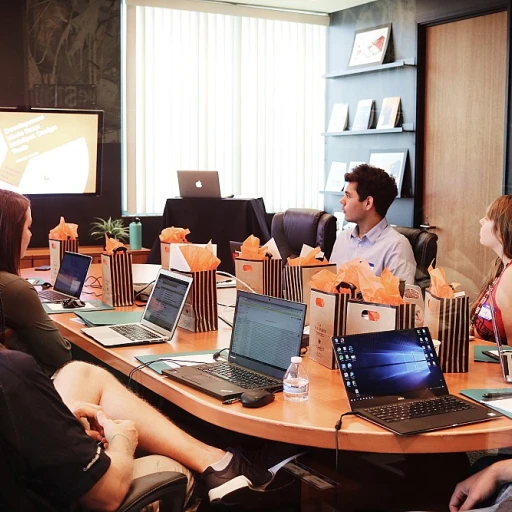
Understanding Acquihire and Its Impact on Upskilling
Decoding Acquihire in the Context of Upskilling
In today’s dynamic business landscape, acquihire has emerged as a strategic maneuver to not only bolster a company's capabilities but to integrate fresh talent into its ranks. This process involves acquiring a target company primarily for its skilled employees rather than its products or services. The driving force behind such transactions often lies in securing key employees who bring a myriad of skills and expertise. While this can significantly benefit the acquiring company, it also implies a need for immediate focus on upskilling. When a business opts for an acquihire, the priority is to merge the new team members seamlessly into existing teams. This introduces the necessity of joint training initiatives and efficient upskilling processes. Time is of the essence, as the quicker the integration, the sooner the combined teams can work cohesively and effectively. The objective is to ensure that the acquired talent aligns with the acquiring company's long-term goals and business strategy, an endeavor where upskilling plays a pivotal role. The merging of companies through acquihire also highlights the varied skill levels among different teams. The challenge then becomes not just about assimilating new employees but enhancing their skillsets to match the acquiring company's standards. This emphasizes the strategic importance of skill development programs tailored to meet the specific needs of both the company and its new hires, resulting in a balanced workforce equipped to face future challenges. Moreover, for companies entrenched in regions known for high innovation like Silicon Valley, these transactions are integral to staying competitive. Firms within such ecosystems continually seek to enhance their human capital, making acquihire an attractive strategy. However, this brings forth another layer of complexity where strategic planning for training initiatives becomes crucial. Engaging in talent enhancement exercises can bridge any gaps swiftly, leading to successful integration and, in the long run, more robust company performance. To navigate these waters effectively, understanding the facets of workforce integration is crucial. For a deeper insight into crafting comprehensive upskilling strategies that align with your company's goals, consider exploring this comprehensive guide on enhancing skills in the workforce.The Role of Upskilling in Successful Acquihire Strategies
Positioning Upskilling as a Catalyst for Acquihire Success
In the intricate mosaic of acquisitions and mergers, acquihire stands out as an innovative strategy where acquiring companies prioritize talent over tangible assets or products. This approach paves the way for strategic integration of key employees and necessitates a shift in focus towards effective upskilling of teams. But how does upskilling play a pivotal role in the triumph of an acquihire transaction? Ensuring Seamless Integration One of the primary aims of upskilling during acquihire is to ensure that team members from the target company blend seamlessly with the acquiring company. As acquihired employees transition into new roles, their ability to adapt swiftly to different business models and strategies becomes crucial. Upskilling helps bridge any gaps in knowledge, aligning them with the acquiring company's vision and goals, thereby making the whole process more harmonious. Promoting Continuous Innovation In the fast-paced world of Silicon Valley and beyond, the innovation quotient of a business can mean the difference between success and failure. Upskilling transforms acqui teams into reservoirs of new ideas and approaches, enhancing the company's competitive edge. When companies invest time in training these new team members, it signals a commitment to nurturing their talents and leveraging their creativity, which is vital in sustained business growth. Enhancing Business Process Management It's often the case that acquihires come with their own set of processes, tools, and practices. To maximize the potential and synergy of these acquired teams, companies must focus on enhancing skills that pertain to effective digital transformation in business process management. This could mean introducing them to new technologies or helping them refine existing skills to better align with emerging trends. By doing so, businesses can ensure they are well-equipped to handle the evolving demands of today's markets. Read more about enhancing skills for effective digital transformation in business process management. Formulating a Strategic Upskilling Framework For a smooth transition, acquiring companies must develop a strategic upskilling framework. This encompasses identifying key skills that are essential for success, creating personalized development plans, and ensuring resources are available for continuous learning. Such a well-formulated strategy not only boosts employees' confidence but also strengthens their loyalty towards the new employer. Companies like those engaged in venture capital often have robust frameworks to enhance the capabilities of key teams, thus ensuring the long-term success of the acquisition. In essence, upskilling isn't just supplementary in the acquihire process; it's central to unlocking the full potential of the transaction. As more companies embrace acquihiring strategies, the ability to efficiently equip teams with vital skills will likely differentiate successful organizations from those that falter.Challenges in Upskilling During Acquihire
Overcoming Barriers in Skill Development Amidst Acquihire
Acquihire transactions often come with a unique set of challenges in terms of upskilling. As organizations engage in these strategic deals, the process revolves around more than just transferring key talents. Companies frequently aim to retain team members from the target company, but the path to upskilling is often nuanced. When a business undergoes acquihiring, the integration of cultures can pose immediate hurdles. Merging diverse teams from different company backgrounds requires careful navigation to ensure a seamless transition. There's a balancing act involved in maintaining the unique creative input of the acquired team while aligning them to the strategic vision of the acquiring organization. One major challenge lies in the difference in skillsets between employees of the two participating companies. Employees from the acquired company might possess expertise in specific company products or services, while the hiring company may focus on distinct technologies or methodologies. Bridging this gap is key for a successful acquisition. Moreover, anxiety among team members regarding job security can lead to resistance toward upskilling initiatives. This concern is heightened in environments where previous mergers and acquisitions have led to workforce reductions. It's strategic for the acquiring company to craft clear communication plans to reassure employees about their future. Additionally, time constraints inherent in these transactions can impede the upskilling process. Rapid integration timelines can pressure teams to deliver results immediately, often sidelining long-term skill development plans. However, for lasting success, organizations need to incorporate upskilling into their deal structure and ensure it's prioritized right after the acquihire transaction. To tackle these challenges effectively, it's vital for companies to lay down structured strategic hiring plans. As noted in Understanding the Foundations of Skill Acquisition Goals, clear target setting in skill development is crucial. This planning enables both acquiring and acquired teams to focus on specific, measurable upskilling objectives while navigating the intricacies of the transaction. Ultimately, addressing these barriers head-on can transform potential obstacles into opportunities for growth. By fostering an environment where teams are encouraged and supported to learn, businesses can greatly enhance the success of the acquihire and drive innovation forward.Effective Upskilling Techniques for Acquihired Teams
Optimizing Skill Development for Acquihired Teams
Navigating the intricate landscape of acquihire can be challenging, but effective skill development strategies are essential for ensuring a smooth transition of teams and a successful integration into the acquiring company. Several techniques stand out in optimizing the performance and adaptability of acquihired team members.
Firstly, a clear understanding of the products and services of both the target company and the acquiring organization establishes the foundation for tailored upskilling initiatives. Strategically aligning these initiatives with the company's long-term goals boosts employee engagement and satisfaction.
Peer mentoring and cross-functional collaborations can provide hands-on learning opportunities. Encouraging key employees to share their expertise not only aids in integrated learning but also bridges business cultures between the teams. Building internal networks where personnel can exchange knowledge facilitates teamwork and innovation in this acquihire context.
Furthermore, introducing technology-driven learning platforms facilitates continuous education and monitoring of progress through personalized content delivery. Companies investing in such platforms ensure readiness for future industry shifts, a necessity in today's fast-paced environment where mergers acquisitions are commonplace.
The role of leadership is paramount in this process. Leaders should communicate transparently about the direction in which the acquihire transaction will steer the company. Regular updates and feedback loops help build trust and align expectations among all stakeholders in the deal.
Implementing these effective strategies during an acquihire could be the difference between a team ready to take on new challenges and one that struggles to adapt. By doing so, companies can turn potential obstacles into opportunities, fostering an environment where innovation thrives, and acquisitions are genuinely accretive to company value.











